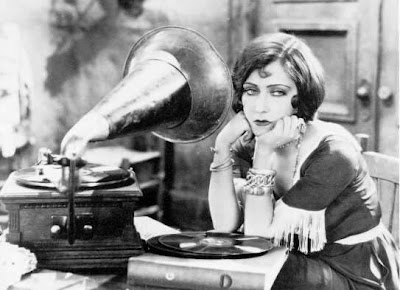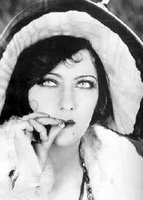Monday, April 17, 2006
When both she and the pictures were big

By Edward Copeland
Until I sat down to watch the DVD of 1928's Sadie Thompson, which brought Gloria Swanson her first best actress Oscar nomination (one of the original trio of best actress nominees in Oscar's inaugural year), it never occurred to me how little of Swanson I have actually seen. Before watching this film, the only things I'd seen Swanson in were Sunset Blvd., Airport '75 and an episode of The Beverly Hillbillies.
Sadie Thompson marked my first encounter with Swanson in her silent glory when she truly was a superstar much as the Norma Desmond she would portray in Sunset Blvd. In fact, in 1928, Swanson was so powerful that she was one of the few women to have their own production companies — Sadie is credited as a Gloria Swanson Production.

Written and directed by Raoul Walsh (who also plays a pivotal role), Sadie Thompson was an adaptation of Somerset Maugham's short story "Miss Thompson," which had been turned into a stage success and already had one film incarnation prior to this one. It would later be remade as a talkie called Rain in 1932 starring Joan Crawford and again in 1953 with Rita Hayworth in Miss Sadie Thompson. The only two versions I've seen are the Swanson and Crawford ones and the contrast is fascinating, not only because the story is the same but because of the differences when one film's actor can use their voice and one cannot. Sadie Thompson also is interesting because much of the film's final reel has been lost and for the DVD, it has been re-created using still photos and, in one sequence, lifting footage from Rain and removing the sounds. Watching Swanson in silence though really emphasizes the power she had in the silent era. You can see some of the flamboyant gestures she let Norma use 22 years later, but she has true power, spark and humor playing the good time girl who becomes the object of a preaching moralist out to save her soul and protect society from the likes of her. (Are we sure who the Beatles wrote "Sexy Sadie" about?)
It's really almost pointless to try to compare Sadie Thompson and Rain since the silent versus talkie depictions change the equations entirely. Crawford is probably just as good in the 1932 version, but she gets dialogue to almost make it an unfair fight. However, even with these differences, it is easy to compare the worth of the actors playing the moralists in the two version.
Lionel Barrymore in the silent version is all sinister, so much so that when the film's climax arrives, it really seems out of character. In contrast, Walter Huston's performance in the 1932 film is more fully realized. While he is still the villain of the piece, he's still unmistakably human so his ultimate fate seems like a natural progression.
Even with the cobbled-together final minutes, Sadie Thompson is worth a look, especially for Oscar completists. Rain is just as good and comparing the two films is a fascinating thing to behold. I saw Rain first — and a long time ago — but I'm not sure the order matters and the Sadie Thompson DVD includes the final minutes of Rain as a bonus feature. Sadie is probably more important, if only for a look at the power that Gloria Swanson once wielded in Hollywood, especially for those of us who know her only as Norma Desmond or as herself slumming on The Beverly Hillbillies or hilariously dictating her memoirs into a tape recorder on the doomed jetliner in Airport '75.
Tweet
Labels: 20s, Beatles, Crawford, Gloria Swanson, Oscars, Silents, Television, W. Huston, Walsh
Comments:
<< Home
I've only seen a couple of Swanson's silent performances and so far I like her much better as Norma Desmond.
You should check out "Show People" (1928) though, directed by King Vidor and starring Marion Davies (William Randolph Hearst's mistress). She does a great parody of Swanson's on- and off-screen persona.
You should check out "Show People" (1928) though, directed by King Vidor and starring Marion Davies (William Randolph Hearst's mistress). She does a great parody of Swanson's on- and off-screen persona.
"... it's the pictures that got smaller" aye, aye, surr.
Silent Swanson I have only seen in a reconstructed release of Von Sthroheim's "Queen Kelly", which I remember as very good in spite of the mutilation (a fate suffered by many a Stroheim movie: i.e. Greed and the Merry-Go-Round)
I saw "Show people" long ago, and I remember it as a very enjoyable picture, so I second Goran in the recommendation.
Silent Swanson I have only seen in a reconstructed release of Von Sthroheim's "Queen Kelly", which I remember as very good in spite of the mutilation (a fate suffered by many a Stroheim movie: i.e. Greed and the Merry-Go-Round)
I saw "Show people" long ago, and I remember it as a very enjoyable picture, so I second Goran in the recommendation.
My favorite silent Swanson performance in is Male and Female, the 1919 Cecil B. De Mille film (as in "I'm ready for my close-up, Mr. De Mille") which is now available on DVD and a must for all Swanson fans. The plot is derived from Peter Pan author JM Barrie's The Admirable Crichton, in which a wealthy family's yacht is shipwrecked on a desert island - class lines blur as the servants and masters must work together to survive in a strange new environment where class distinctions have become irrelevant. A far cry from the massive epics De Mille would undertake later in his career, Male & Female is intimate, character-driven film that's gorgeously photographed and performed, and surprisingly sophisticated from a technological standpoint for a film made in 1919. As the pampered heiress falling in love with the butler who puts her in her place, Swanson was never more beautiful or sensual, and I think it more than stands up against her best work. It was a lost film for several generations until a print was found and beautifully restored. Take advantage!
Post a Comment
<< Home


